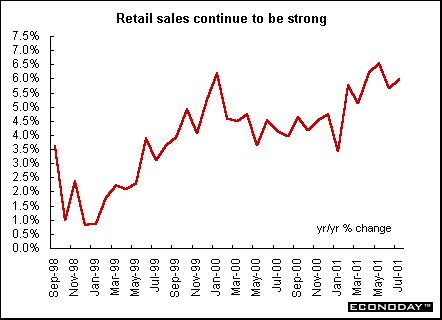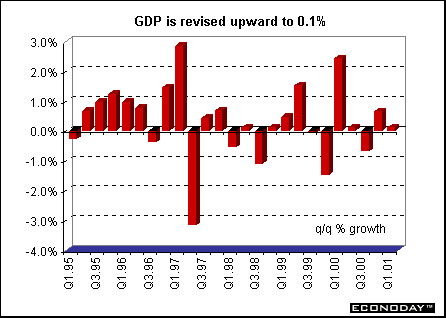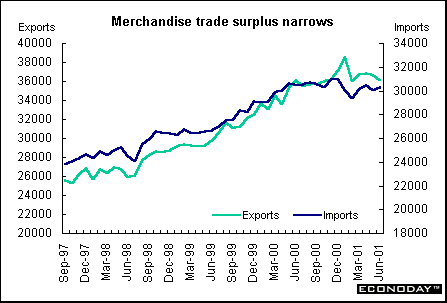
Indicator scoreboard
EMU - July harmonized index of consumer prices (HICP) fell 0.1 percent but rose 2.8 percent when compared with last year. Although the annual rate is easing, it is still above the ECB's price stabilization target of 2 percent. Core HICP - excluding energy, food, alcohol and tobacco - was up 2.0 percent, matching ECB's price stability limit. The HICP itself remained above 2 percent in every member country. July energy prices sank 1.8 percent. Excluding energy the HICP rose 0.1 percent and 2.8 percent on the year.

Germany - June seasonally adjusted Statistics Office retail sales (excluding auto dealerships, petrol stations and wholesale warehouses) fell 1.8 percent but rose 0.5 percent when compared with last year. Seasonally adjusted real Bundesbank data show that retail sales excluding autos and transactions at gas stations fell 1.1 percent on the month and 0.7 percent on the year. When those two categories are included - making the data not directly comparable with the figures from the statistics office - overall retail sales fell 1.3 percent and 0.6 percent on the year.

July wholesale prices fell 0.8 percent but were up 2.2 percent when compared with last year. Excluding oil products, wholesale prices fell 0.5 percent and were up 2.3 percent when compared with last year. Every category showed a price decline except for durable goods. Overall seasonal food prices dropped 4.0 percent in a continued correction of the overshooting seen in previous months. Products from energy producers were down 3.2 percent. Many analysts view WPI cautiously, given the high weighting of oil products in the index, and say that producer price data (due out next week) provide a better picture of the German inflation situation.
France - June seasonally and workday adjusted manufacturing output rose 0.2 percent and 2.6 percent when compared with last year. Industrial output rose 0.3 percent and 2.3 percent on the year. Semi-finished and capital goods output were both flat on the month, underlining the stagnation in industry demand especially in the electronics branch.
Second quarter employment growth slowed to the creation of 63,900 net non-farm jobs, down from 103,900 in the first quarter. This represented a second quarter payroll gain of 0.4 percent after a 0.8 percent increase in the first quarter. Services sector jobs rose 0.6 percent and construction added 0.7 percent, while industry fell 0.1 percent. Monthly base salaries in non-farm, non-government sectors rose by an average of 0.5 percent after gaining 0.9 percent in the first quarter. Hourly base wage gains also decelerated, rising 0.7 percent, of which 0.1 percentage point was due to the mechanical effects of shortening the workweek for a larger number of firms.
Britain - July producer input price index dropped 1.8 percent and was down 0.3 percent when compared with last year. The large drop in input prices was mainly due to an 11.8 percent monthly decline in the price of crude oil. Compared with last year oil prices were down 6.1 percent, the largest annual decline since February 1999. Producer output prices fell 0.2 percent but were up 0.1 percent on the year. Excluding food, beverages, tobacco and petroleum, seasonally adjusted core output prices remained unchanged on the month in July to stand 0.2 percent above levels a year earlier.
July seasonally adjusted retail price index fell 0.6 percent but was up 1.6 percent when compared with last year. The retail price index excluding mortgage interest payments (RPIX) also dropped 0.6 percent and rose 2.2 percent when compared with last year. A large drop in seasonal food prices drove RPIX inflation further below the government's 2.5 percent target.

Average earnings rose 4.8 percent in the three months to June following an upwardly revised 4.6 percent rate in the three months to May. The June increase was above the Bank of England's 4.5 percent target for non-inflationary wage growth. Excluding bonuses, average earnings rose 5.3 percent compared with 5.1 percent in May. Manufacturing sector average earnings in the three months to June rose 5.0 percent versus 5.1 percent in the three months to May.

July claimant unemployment rate remained at 3.2 percent. The number of unemployed fell by 12,800. Employment in the three months from April through June rose 75,000 versus the previous three months, for a participation rate of 74.8 percent. Manufacturing employee jobs fell by 110,000 to 3.85 million in the period to June compared with a year earlier. Unemployment as measured by the International Labour Organization (ILO) fell for the three months April to June by 0.1 percent to 5.0 percent from the previous three months and 0.5 percent on the year.

July seasonally adjusted retail sales volumes rose 0.6 percent and 6 percent when compared with last year. The increase was boosted by a 1.3 percent monthly rise in the textile, clothing and footwear category. This increase took the annual rate of sales in this sector to 11.8 percent, the highest figure since records began in 1986. Part of the strength in textile, clothing and footwear volumes was due to heavy discounting for summer sales, although the value growth in this sector was also strong.

Asia
Japan - Revised first quarter gross domestic product rose 0.1 percent rather than contracting 0.2 percent. Consumer spending, which accounts for about 55 percent of the economy, rose a revised 0.6 percent in contrast with the initial estimate that said spending was unchanged. Business spending, which accounts for about 15 percent of gross domestic product, fell 0.9 percent, compared with an initial estimate of a 1 percent decline. The second quarter GDP report will be released September 7.

Americas
Canada - June manufacturing shipments contracted 1.9 percent, erasing May's increase. Motor vehicles, computers and electronic products pulled shipments down. June's result is the third monthly decrease in 2001. Shipments in 16 of 21 industries representing 83 percent of the total shipments decreased in June. Inventories edged up 0.1 percent as finished product inventories rose for the fourth time in six months. Unfilled orders slipped 0.6 percent, led by diminishing orders for the aerospace product and parts and computer and electronic products industries.
June merchandise trade surplus fell to C$5.8 billion. A sharp decline in the value of energy exports, mainly electricity, along with weakness in most major sectors resulted in an overall decline in exports in June. Imports rose slightly as strong growth in the automotive and consumer goods sectors was partially offset by declines in energy imports. Exports dropped 1.4 percent while imports gained a slight 0.8 percent. Merchandise exports to the United States declined 1.1 percent and imports rose 1.5 percent. Consequently, the trade surplus with the United States fell from just under C$9.0 billion in May to C$8.3 billion in June.



Introduction • Global
Stock Market Indexes • Recap of Global Markets
• Currencies • Indicator
Scoreboard

The Bottom Line •
Looking Ahead
|